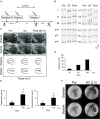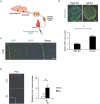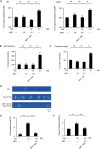Upregulation of neuropeptide Y in cardiac sympathetic nerves induces stress (Takotsubo) cardiomyopathy
- PMID: 36408384
- PMCID: PMC9669346
- DOI: 10.3389/fnins.2022.1013712
Upregulation of neuropeptide Y in cardiac sympathetic nerves induces stress (Takotsubo) cardiomyopathy
Abstract
Substantial emotional or physical stress may lead to an imbalance in the brain, resulting in stress cardiomyopathy (SC) and transient left ventricular (LV) apical ballooning. Even though these conditions are severe, their precise underlying mechanisms remain unclear. Appropriate animal models are needed to elucidate the precise mechanisms. In this study, we established a new animal model of epilepsy-induced SC. The SC model showed an increased expression of the acute phase reaction protein, c-Fos, in the paraventricular hypothalamic nucleus (PVN), which is the sympathetic nerve center of the brain. Furthermore, we observed a significant upregulation of neuropeptide Y (NPY) expression in the left stellate ganglion (SG) and cardiac sympathetic nerves. NPY showed neither positive nor negative inotropic and chronotropic effects. On the contrary, NPY could interrupt β-adrenergic signaling in cardiomyocytes when exposure to NPY precedes exposure to noradrenaline. Moreover, its elimination in the left SG via siRNA treatment tended to reduce the incidence of SC. Thus, our results indicated that upstream sympathetic activation induced significant upregulation of NPY in the left SG and cardiac sympathetic nerves, resulting in cardiac dysfunctions like SC.
Keywords: Takotsubo cardiomyopathy; cardiac sympathetic nervous; neuropeptide Y; stellate ganglion; stress.
Copyright © 2022 Arai, Kanazawa, Kimura, Munakata, Yamakawa, Shinmura, Yuasa, Sano and Fukuda.
Conflict of interest statement
The authors declare that the research was conducted in the absence of any commercial or financial relationships that could be construed as a potential conflict of interest.
Figures




Similar articles
-
Neuropeptide Y (NPY) and the pig heart: release and coronary vasoconstrictor effects.Peptides. 1986 Sep-Oct;7(5):821-6. doi: 10.1016/0196-9781(86)90101-4. Peptides. 1986. PMID: 3025824
-
The effects of neuropeptide Y on myocardial contractility and coronary blood flow.Br J Pharmacol. 1991 Sep;104(1):195-201. doi: 10.1111/j.1476-5381.1991.tb12407.x. Br J Pharmacol. 1991. PMID: 1838493 Free PMC article.
-
Differential inhibition of neuropeptide Y on the chronotropic and inotropic responses to sympathetic and parasympathetic stimulation in the isolated, perfused dog atrium.J Pharmacol Exp Ther. 1991 Oct;259(1):38-43. J Pharmacol Exp Ther. 1991. PMID: 1920125
-
Effects of antihypertensive drugs on sympathetic vascular control in relation to neuropeptide Y.J Cardiovasc Pharmacol. 1987;10 Suppl 12:S51-68. J Cardiovasc Pharmacol. 1987. PMID: 2455193 Review.
-
Pivotal role of the sympathetic nerves of the human heart in mental stress responses and triggered cardiovascular catastrophes.Auton Neurosci. 2022 Jan;237:102925. doi: 10.1016/j.autneu.2021.102925. Epub 2021 Dec 1. Auton Neurosci. 2022. PMID: 34896690 Review.
Cited by
-
Molecular and cellular neurocardiology in heart disease.J Physiol. 2025 Mar;603(7):1689-1728. doi: 10.1113/JP284739. Epub 2024 May 22. J Physiol. 2025. PMID: 38778747 Review.
-
Bayliss Starling Prize Lecture 2023: Neuropeptide-Y being 'unsympathetic' to the broken hearted.J Physiol. 2025 Mar;603(7):1841-1864. doi: 10.1113/JP285370. Epub 2024 Jun 7. J Physiol. 2025. PMID: 38847435 Free PMC article. Review.
-
Stellate Ganglia: A Key Therapeutic Target for Malignant Ventricular Arrhythmia in Heart Disease.Circ Res. 2025 Apr 25;136(9):1049-1069. doi: 10.1161/CIRCRESAHA.124.325384. Epub 2025 Apr 24. Circ Res. 2025. PMID: 40273204 Review.
-
Animal models of Takotsubo syndrome: bridging the gap to the human condition.Front Cardiovasc Med. 2024 May 22;11:1351587. doi: 10.3389/fcvm.2024.1351587. eCollection 2024. Front Cardiovasc Med. 2024. PMID: 38841261 Free PMC article. Review.
References
-
- Anderson J. L., Adams C. D., Antman E. M., Bridges C. R., Califf R. M., Casey D. E., Jr., et al. (2007). ACC/AHA 2007 guidelines for the management of patients with unstable angina/non-ST-elevation myocardial infarction: A report of the American college of cardiology/American heart association task force on practice guidelines (Writing committee to revise the 2002 guidelines for the management of patients with unstable angina/non-ST-elevation myocardial infarction) developed in collaboration with the American college of emergency physicians, the society for cardiovascular angiography and interventions, and the society of thoracic surgeons endorsed by the American association of cardiovascular and pulmonary rehabilitation and the society for academic emergency medicine. J. Am. Coll. Cardiol. 50 e1–e157. 10.1016/j.jacc.2007.02.013 - DOI - PubMed
LinkOut - more resources
Full Text Sources
Miscellaneous

